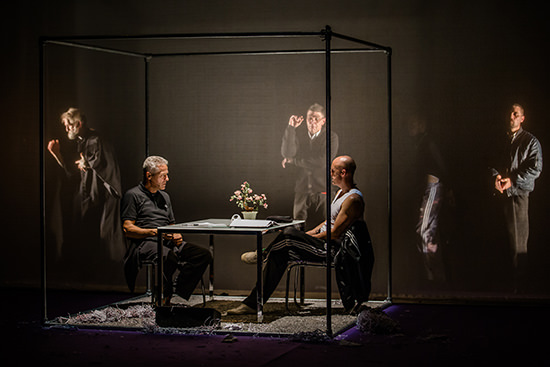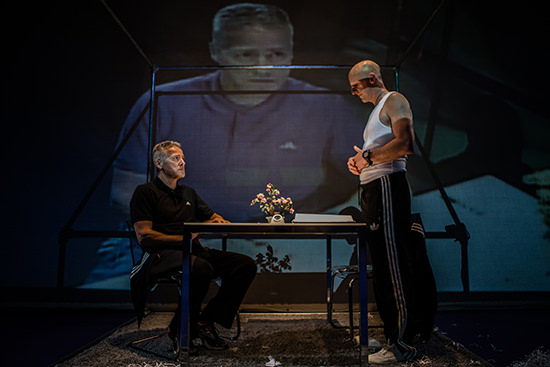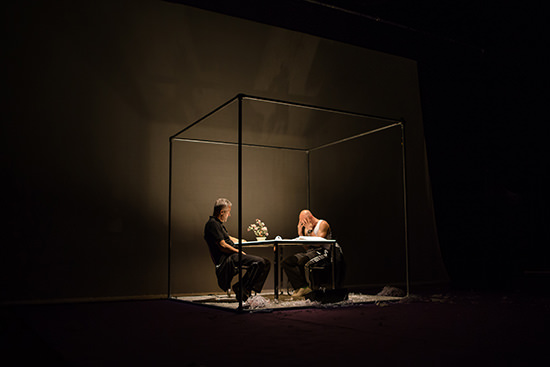 |
The Chat, Arts House photo Bryony Jackson |
A confession: my experience with James Brennan's remarkable collaborative work The Chat might have been coloured by my sitting in on a brief slice of its rehearsal, though 'rehearsal' is an inadequate word for the hour I witnessed. There was a point during that practice run when I lost all perspective on where 'rehearsal' ended and where the performance really began. The Chat doesn't so much erase the boundaries between artifice and reality as multiply them, to produce a head-spinning kaleidoscopic effect. It wasn't just me. On the evening I saw the final work, audience members were actually storming the stage to intervene in the action.
The rawest premise upon which The Chat operates is provocative enough: real ex-criminals and actors play out an improvised parole interview. The ex-offender decides on the nature of the crime and the circumstances surrounding the possible probation, and the interview goes on to assess whether it should be granted.
While the parole officer is clearly an actor (David Woods), the ex-offender himself is playing a role too, albeit one he is particularly qualified to inhabit. Since we don't know his real background, the level of fiction or veracity in the history of crime and punishment being explored in front of us is unknowable.
Once the if-not-fictional-then-at-least-fictionalised roleplaying scenario is established, parolee and parole officer switch sides. Woods steps into the role of the offender and the real ex-offender playing an ex-offender begins playing the parole interviewer. He tests Woods, digging into his past or making propositions about his motivations, perhaps getting angry, perhaps attempting to penetrate his defences. All of this is improvised, remember, but the shifts in power come thick and fast as the inherent authority dynamics of the parole interview format become clear.
 |
The Chat, Arts House photo Bryony Jackson |
All of this is being assessed not just by the audience but by the ensemble of fellow ex-criminals who are rotating their roles throughout the season. At various points they interject, lambasting Woods for caricature or the performing ex-offender for going too light on him. Other actors play facilitators or directors pushing the fiction this way or that, but this only makes it harder to distinguish the structural dynamics of the work as a whole —just as the parole interview is both a performance and a power play, so is every one of the various frames around it.
There are many, many more reflecting surfaces in this ‘funhouse,’ not least of which is Brennan's in-built criticism of both the parole interview (he's a former parole officer himself) and the very format of inverted role-play that he has invented for this work. It's hugely intriguing, the idea that criminals can gain new perspectives on themselves by switching roles with an interviewer, but Brennan knows the limits of utopian thinking, and keeps that in the spotlight here, too.
In the end, the audience plays the parole board who will decide whether the man in the chair goes back to prison or whether he walks free. But we've gone so far into the woods by this point—watching a real ex-convict don a fictional role, who then dons another fictional role, which then interrogates an actor simulating one (or more) of those roles, while many others criticise and direct both performances—that by the time the question of how we're to finally pass judgement on the man is put to us, it's no wonder that some audience members lose sight of the fact that their decision isn't that of a real parole board.
On the night I attended, people were shouting out offers of jobs, mentoring, cooking lessons, all in exchange for the freedom of the man they thought they'd just seen reflected in this endlessly complicated house of mirrors. That a performance so embroidered with artifice, embellishment and absurdity can somehow seem to connect with such a deeper reality is astonishing, and like many of those in the room I could have stayed in this realm for many more hours. It will stay with me for much longer.
 |
The Chat, Arts House photo Bryony Jackson |
The Chat, concept, lead artist JR Brennan, co-creators J R Brennan, David Woods, collaborating artist Ashley Dyer, performers Nick Apostolidis, Arthur Bolkas, JR Brennan, Ashley Dyer, Ty Luke, Nick Maltzahn, John Tjepkema, David Woods, lighting Jennifer Hector; Arts House, North Melbourne Town Hall, 27-31 July
RealTime issue #134 Aug-Sept 2016 pg.
© John Bailey; for permission to reproduce apply to [email protected]








 back
back